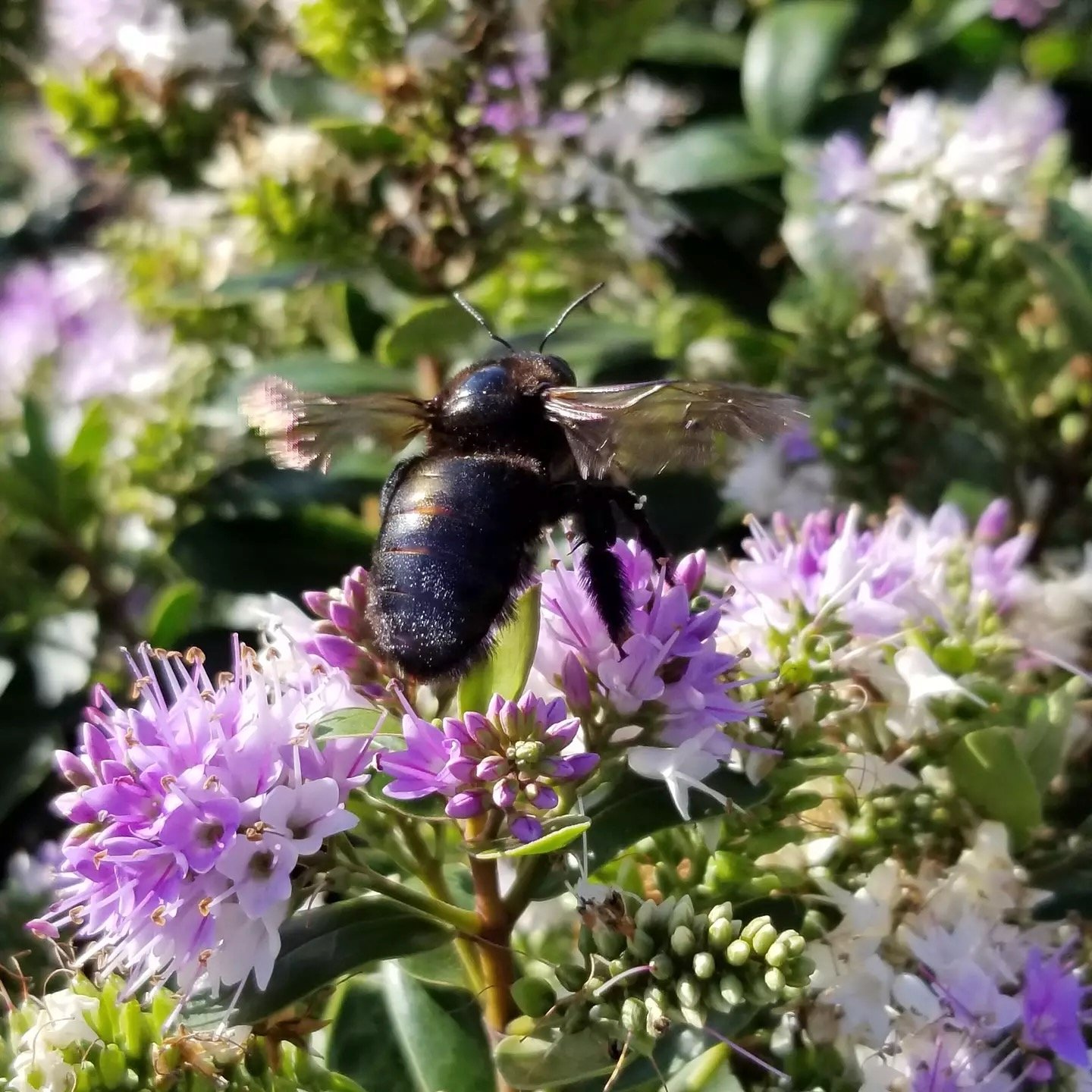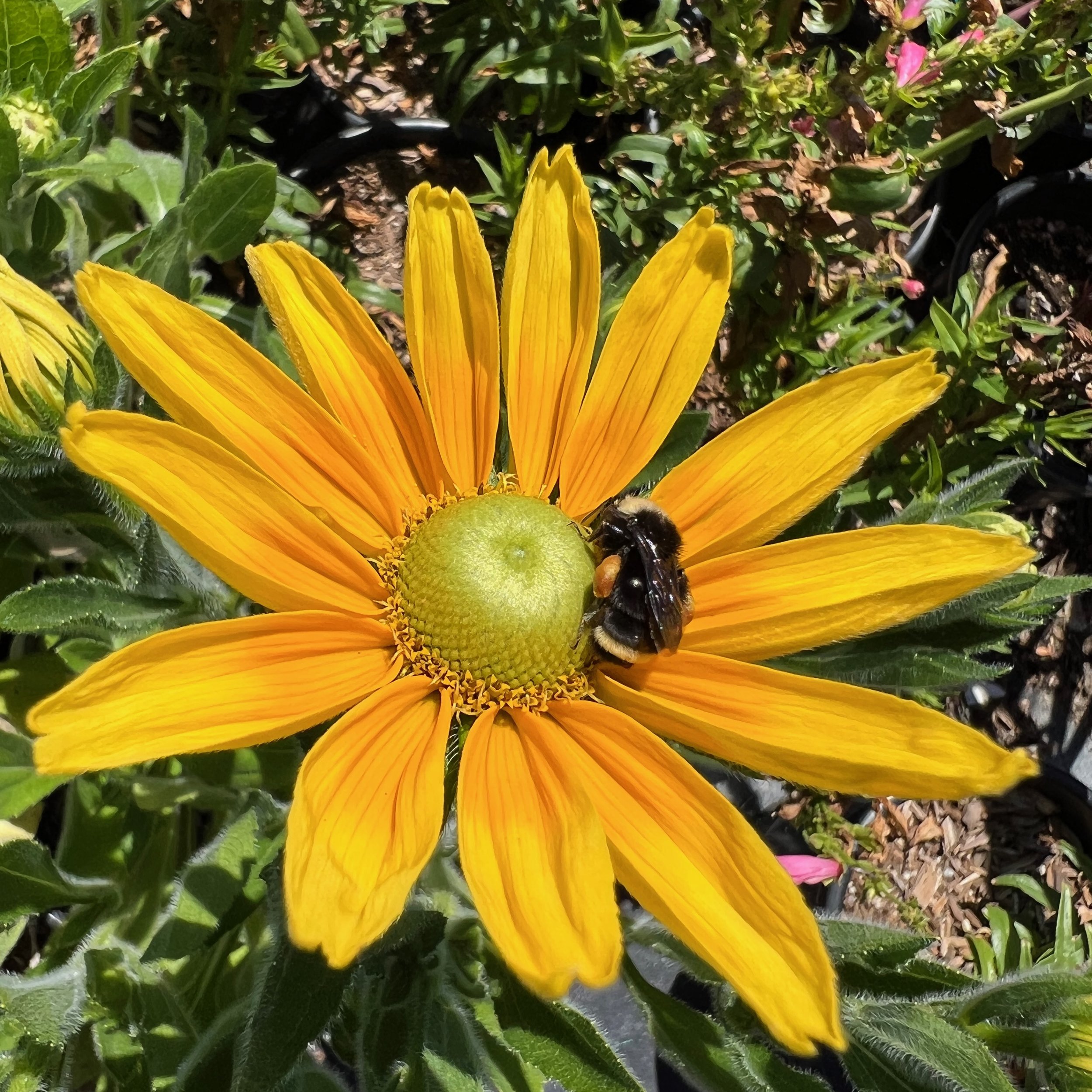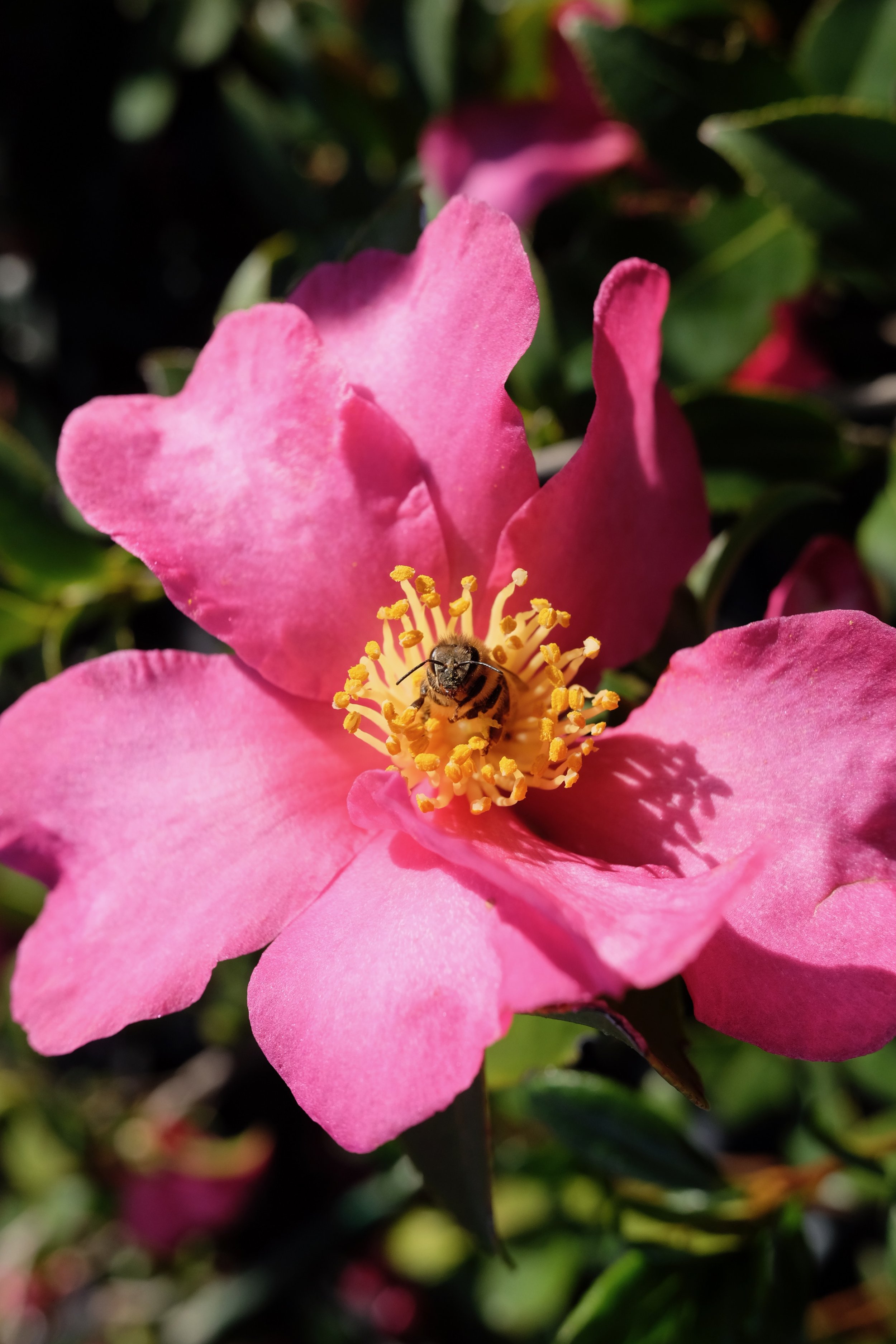Did you know that there are over 1,600 different native bees in California? Unfortunately, sharp declines in their populations in recent years means that several species are being considered for the endangered species list; even the common yellow-faced bumblebee is facing environmental stress (POLLINATORS IN PERIL: CALIFORNIA’S NATIVE BEES FACE AN UNCERTAIN FUTURE; Tahoe Quarterly, Fall 2023).
This is concerning because bees are essential pollinators; their decline has raised concerns about biodiversity and food security. “As bee habitats have been simplified or outright lost, we lose the continuity of floral resources that a diverse community of bees depends on over time,” says Dr. Neal Williams, professor of entomology at the University of California, Davis. Read more here.
However - there’s so much you can do in your own yard to help save the bees! To support a healthy bee population, it’s recommended to plant a wide variety of plants that bloom at different times of the year, providing nectar and pollen to different species of bees as they come out of hibernation at different times of the year.
As we pass through the summer solstice, here are some of our favorite summer-blooming, bee-supporting plants:
Western honey bee on Teucrium cossoni ‘Majoricum’ - While the Western honey bee is not native to California, it does play a n important role in the pollination of California almonds and other crops used for human food production.
Teucrium (Germander)
Teucrium, aka Germander, is a bee magnet. Some varieties such as Teucrium fruticans are fall-winter bloomers, while Teucrium cossoni ‘Majoricum’ - shown here, being visited by a Western honey bee - is a petite summer bloomer that grows to about 2 feet wide and less than a foot tall. Covered in tiny purple flowers, this one is an absolute bee magnet and when you walk by it in the nursery, you’ll sense it buzzing with the many bees who have come to enjoy its nectar.
In this image, you can see a male Valley Carpenter bee enjoying some nectar from a flower on a non-native Salvia.
Salvia (Sage)
While Salvias generally reach their peak in late spring, many continue to bloom into summer. There are many native Salvias including “Bee’s Bliss” that are a wonderful choice to support native bee populations, using minimal water and adapting easily to our Bay Area environment. But even non-natives like the Salvia pictured to the left provide nectar to bees and other pollinators.
Bee-Friendly Gardening Tips
Plant diverse. Plant a variety of flowers to provide continuous blooms throughout the year.
Avoid pesticides. Minimize or eliminate pesticide use to protect bees from harmful chemicals. Neocotinoids are especially harmful - go here (it will open a PDF from BeeAction.org) to see a list of specific products to avoid.
Create habitat. Provide nesting sites by leaving some bare ground for ground-nesting bees and installing bee hotels for cavity-nesting species.
Provide water sources. Provide shallow water sources in or near your garden with stones, marbles, or even old wine corks for bees to land on. (Thanks to Anthony for this tip!)
Plant native in 70% of your garden. To learn why pollinators need native plants and vice versa, visit this helpful page from the National Parks Service.
Plant in groups. Pollinators prefer clumps of flowers over single flowers. (Source: University of California) Ideally, plant in groups of 3 ft x 3 ft.
Plant in color. Bees have good color vision and flower colors that particularly attract bees are blue, purple, violet, white and yellow. (Source: University of California)
Western honey bee on Verbena bonariensis
Verbena bonariensis (Tall Verbena)
A popular landscaping plant in the Bay Area, Verbena is also very attractive to bees, blooming with clusters of tiny purple flowers atop tall stems from spring to fall.
Because Verbena can become overly rambunctious in parts of California, you may consider limiting planting to containers or smaller areas.
Western honey bee on Agapanthus ‘Baby Pete’
Agapanthus (Lily of the Nile)
You’ll see bees climbing into the center of the Agapanthus flowers, as seen here on Agapanthus ‘Baby Pete.’ Blooming from late spring through the summer, the up to 100 flowers on each flower head of Lily of the Nile also attract butterflies and hummingbirds. They do well in large containers, so a grouping of Agapanthus would look great in a patio garden or on a deck.
Western honey bee on Gaillardia x grandiflora
Gaillardia x grandiflora (Blanket Flower)
This daisy-style, colorful flower is popular with many native bees. Blooming late spring through summer (sometimes even into autumn), Blanket Flower also attracts butterflies and birds. It is also drought tolerant once established and is a great choice for a low-water garden.
Why to Plant Native
While just a few of the plants on this list are natives, all support native bee populations by providing nectar and/or pollen. In turn, the bees help to pollinate fruit and vegetable plants, increasing our food supply. While all bees pollinate, the California Native Plant Society reports that native bees are 200 times more efficient at pollination than honey bees!
Many California natives are fall- or winter-blooming, so to maximize nectar availability in your yard, one idea is to plant majority California native cool-season bloomers, and mix in other plants, such as those on this list, for your summer-blooming garden.
To learn more about native plants, you may enjoy this article, The Green Switch: Persuading My Parents to Embrace CA Native Plants, from Bay Area designers Smart Yards Coop.
Leaf cutter bee on Eriogonum fasciculatum foliosum
Eriogonum fasciculatum
(California Buckwheat)
California Native Eriogonum fasciculatum is an earth-friendly, bee- and other wildlife- supporting, summer-flowering shrub that “also provides numerous ecosystem services for humans, including erosion control, post-fire mitigation, increases in crop yields when planted in hedgerows, and high habitat restoration value.” (CalFlora.org)
It’s also drought-tolerant and quite attractive, with white and pink flowers sitting atop tall stems. The variety shown here grows to 3 ft tall and wide. See some amazing photos along with tons of information about this plant here.
Yellow-faced bumble bee on Coyote Mint
Monardella villosa (Coyote Mint)
This California native in the mint family is very attractive to bees (and butterflies, too!). Boasting pretty purple puff-shaped flowers from June through August, this is another summer-blooming California native that is an absolute must for your bee garden! Drought-tolerant; flowers increase with some light irrigation.
Penstemon heterophyllus ‘Electric Blue’
Penstemon (Beardtongue)
Did you know bees see some colors better than others? You may have noticed that many of the plants on this list are blue or purple, which bees are naturally attracted to. The California native Penstemons (including other native varieties such as Penstemon heterophyllus ‘Catherine De La Mare’ and Penstemon spectabilis - Showy Penstemon) are very attractive to bees, hummingbirds, and other pollinators. This is another summer-blooming California native that your summer garden can’t do without!
Penstemons stay somewhat small, growing into a 2-4 ft x 2-4 ft clump of brightly-colored flowers. They are also available in a reddish purple; see Penstemon heterophyllus ‘Margarita Bop’.
More Resources
California specific:
The Value of Bees (SaveSFBay.org)
Bee Friendly Gardening (California Native Plant Society)
Native Bees in the East Bay (Native Here Nursery)
Beyond the Honey Bee: Learn More About California Native Bees (UC Arboretum)
General information about saving bees:
10 Ways to Save the Bees (TheBeeConservancy.org)
Resource Library (PlanetBee.org)
Female Valley Carpenter bee on Hebe ‘Co-Ed’
Hebe
Bees adore Hebes, New Zealand shrubs that fare well in our climate. Their late summer to fall blooming flowers are stunning and will also attract all kinds of bees to your garden. These easy care little shrubs grow to about 3 ft tall by 4 ft wide and can be grown in sun or shade.
Yellow-faced bumble bee on Rudbeckia hirta
Rudbeckia hirta (Black-eyed Susan)
Blooming from summer into fall, the large-flowered Rudbeckia hirta produce a lot of nectar and pollen that attract bees and other pollinators. Their oversized, yellow flowers are also attractive in the garden and for bouquets. Despite not being native, Rudbeckia is still a healthy ecosystem addition; it serves as a host plant for butterflies and provides food for other wildlife.
Seven-spined woodcarder bee on Catmint
Nepeta (Catmint)
The pretty purple flower spires of Nepeta attract a wide variety of bees (as well as butterflies and hummingbirds). They bloom through the summer, sometimes into fall. As the name suggests, the scent of this plant is also attractive to some cats!
VIDEO: Nepeta faassenii (Cat’s Meow Catmint), shown in the video below, is a mound-forming Catmint that makes a very pretty effect when in bloom with its light green, almost silver foliage and delicate purple flowers. Bees love it!
Yellow-faced bumble bee on English Lavender
Lavandula (Lavender)
As any herb-lover knows, Lavender is covered with tons of bees all summer long. We have many different varieties at the nursery and encourage you to come visit and see them in person; some Lavenders are more attractive to bees than others. In the meantime, please enjoy two videos below of Lavandula ‘Hicote’ and Lavandula ‘Otto Quast’.
And a bonus photo….
This was actually taken in winter, but it’s my favorite photo I’ve ever taken of a bee, and so of course we had to include it!














